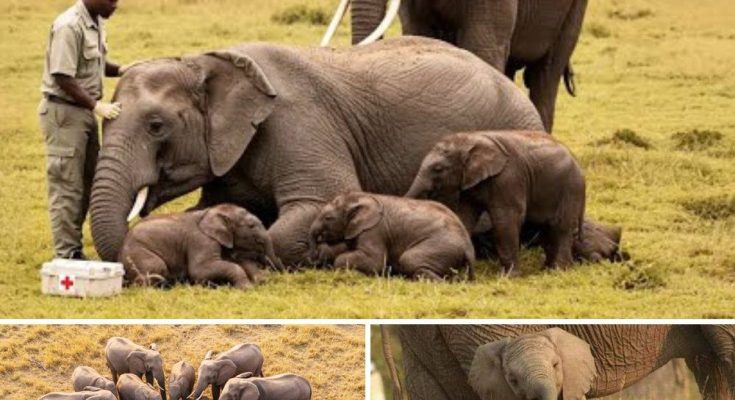At sunrise, a soft golden glow bathed the African savannah. Birds were just beginning their morning calls. Rangers on patrol moved quietly through the brush, scanning the horizon for movement. Then, in a moment they would never forget, the silence was broken by the cries of not one but two newborn elephant calves.
A mother elephant had given birth — not to a single calf, which is the norm, but to rare twins, an event so extraordinary that even veteran wildlife experts can go decades without seeing it.
Why Elephant Twins Are So Rare
Elephants usually give birth to one calf after a 22-month pregnancy — the longest of any land mammal. Twin births occur in less than one percent of cases, making them one of the rarest sights in the wild. The physical toll on the mother is enormous, and the survival of both calves is never guaranteed. That is why what happened next stunned everyone present.
A Moment of Awe in the Wild
The two calves, still damp from birth, huddled against their mother’s massive legs. Her trunk reached out, touching each baby in turn, almost as if counting them, comforting them, and reassuring herself that they were real. This gentle display of maternal care is typical of elephants, whose emotional intelligence rivals that of primates and dolphins.
The Herd Rallies Instinctively
Within minutes, heavy footsteps echoed from the surrounding brush. One by one, towering gray shapes emerged — the rest of the herd. Without hesitation, they formed a wide circle around the mother and her twins. From above, the scene resembled a living ring of protection. It was not planned; it was instinctual, passed down over millennia.
Wildlife specialists say such coordinated behavior shows how elephants use empathy and social bonds to safeguard their most vulnerable members. It’s a breathtaking example of the complex social life of elephants.
First Wobbly Steps Into a New World
Despite the exhaustion of labor, the mother elephant gently nudged each calf with her trunk. With encouragement from her and the reassuring presence of the herd, the newborns tried to stand. Their small, soft trunks curled awkwardly as they stumbled and swayed. Then, under a chorus of trumpeting calls, both calves managed their first unsteady steps. The sound carried across the plains like a cheer at a family celebration.
The Power of Elephant Family Bonds
Elephants are celebrated for their strong emotional connections. They grieve their dead, recognize old friends after years apart, and will travel miles to aid an injured relative. But to see an entire herd welcome two newborns — and two rare twins at that — with such reverence and joy was something beyond extraordinary.
A ranger who witnessed the scene later said:
Allomothers and the Secret of Survival
In the days after the birth, the twins remained pressed to their mother’s side. But other females, known as “allomothers,” stepped in to help nurse, guard and guide them. In elephant society, every calf is, in a sense, a shared responsibility. This cooperative care increases the calves’ chance of survival, especially for twins who demand twice as much nourishment and protection.
This is the hidden strength of elephants — not only their size and power but also their capacity for unity, empathy, and family cooperation.
A Viral Reminder of Nature’s Miracles
Photos taken that morning captured everything: the protective ring of elephants, the mother’s tender caresses, and the tiny newborns leaning against her side. When the images reached the internet, they went viral. Viewers around the world were reminded that even in an age of headlines about loss and destruction, nature still produces miracles.
Social media feeds filled with comments about the emotional power of the pictures. Teachers shared them with students to illustrate animal behavior. Wildlife charities used them to raise awareness about elephant conservation.
Lessons From a Rare Birth
Two rare lives were born. An entire herd rose to protect them. And for a brief, heart-stopping moment, everyone — rangers, tourists, online viewers — paused to witness the magic of the natural world.
This remarkable event underscores a simple truth: sometimes the most amazing stories are not written by humans at all but by nature itself. And when we protect wild spaces, we make it possible for such miracles to continue.



